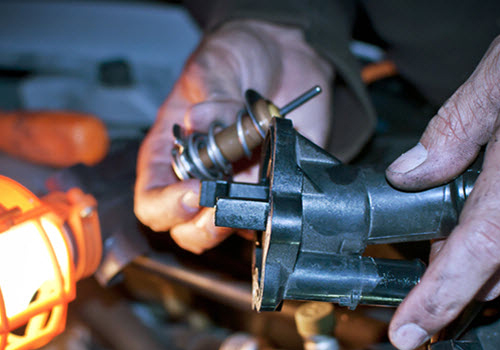Automatic and Programmable Thermostats
Many people's homes are littered with various appliances. These appliances often prove crucial for day-to-day activities, and can be expensive to replace if damaged or destroyed. For this reason, you'll want to learn how to protect household appliances from electrical disturbances. The 2 main types of disturbances that you can protect against are voltage surges and power outages.

What is a Thermostat?

It is a temperature sensitive switch that controls a space conditioning unit or system, such as a furnace, air conditioner, or both. When the indoor temperature drops below or rises above the thermostat setting, the switch moves to the "on" position, and your furnace or air conditioner runs to warm or cool the house air to the setting you selected for your family's comfort. A thermostat, in its simplest form, must be manually adjusted to change the indoor air temperature.
General Thermostat Operation



Thermostats with Automatic Temperature Adjustment
To maximize your energy savings without sacrificing comfort, you can install an automatic setback or programmable thermostat. They adjust the temperature setting for you. While you might forget to turn down the heat before you leave for work in the morning, a programmable thermostat won't! By maintaining the highest or lowest required temperatures for four or five hours a day instead of 24 hours, a programmable thermostat can pay for itself in energy saved within four years.
Programmable thermostats have features with which you may be unfamiliar. The newest generation of residential thermostat technologies is based on microprocessors and thermostat sensors. Most of these programmable thermostats perform one or more of the following energy control functions:



A Note for Heat Pump Owners

When a heat pump is in its heating mode, setting back a conventional heat pump thermostat can cause the unit to operate inefficiently, thereby cancelling out any savings achieved by lowering the temperature setting. Maintaining a moderate setting is the most cost effective practice. Recently, however, some companies have begun selling specially designed setback thermostats for heat pumps, which make setting back the thermostat cost effective. In its cooling mode, the heat pump operates like an air conditioner; therefore, manually turning up the thermostat will save you money.
Types of Automatic and Programmable Thermostats
There are five basic types of automatic and programmable thermostats:





Choosing a Programmable Thermostat
Because programmable thermostats are a relatively new technology, you should learn as much as you can before selecting a unit. When shopping for a thermostat, bring information with you about your current unit, including the brand and model number. Also, ask these questions before buying a thermostat:




Most automatic and programmable thermostats completely replace existing units. These are preferred by many homeowners. However, some devices can be placed over existing thermostats and are mechanically controlled to permit automatic setbacks. These units are usually powered by batteries, which eliminates the need for electrical wiring. They tend to be easy to program, and because they run on batteries, the clocks do not lose time during power outages.
Before you buy a programmable thermostat, chart your weekly habits including wake up and departure times, return home times, and bedtimes, and the temperatures that are comfortable during those times. This will help you decide what type of thermostat will best serve your needs.

Other Considerations
The location of your thermostat can affect its performance and efficiency. Read the manufacturer's installation instructions to prevent "ghost readings" or unnecessary furnace or air conditioner cycling. Place thermostats away from direct sunlight, drafts, doorways, skylights, and windows. Also make sure your thermostat is conveniently located for programming.
Some modern heating and cooling systems require special controls. Heat pumps are the most common and usually require special setback thermostats. These thermostats typically use special algorithms to minimize the use of backup electric resistance heat systems. Electric resistance systems, such as electric baseboard heating, also require thermostats capable of directly controlling 120 volt or 240 volt line voltage circuits. Only a few companies manufacture line voltage setback thermostats.

A Simpler Way to Control Your Environment
The best thermostat for you will depend on your life style and comfort level in varying house temperatures. While automatic and programmable thermostats save energy, a manual unit can be equally effective if you diligently regulate its setting--and if you don't mind a chilly house on winter mornings. If you decide to choose an automatic thermostat, you can set it to raise the temperature before you wake up and spare you some discomfort. It will also perform consistently and dependably to keep your house at comfortable temperatures during the summer heat, as well.
For FREE Online Home Evaluation,
please fill up the form below
Looking for a New Home or Investment Properties
If you have any questions or comments, email me
at [email protected] and they will be included in the market update.
OR if you would like more information on our unique systems and programs, call us at 206-391-7766 or visit our website www.GeorgeMoorhead.com
